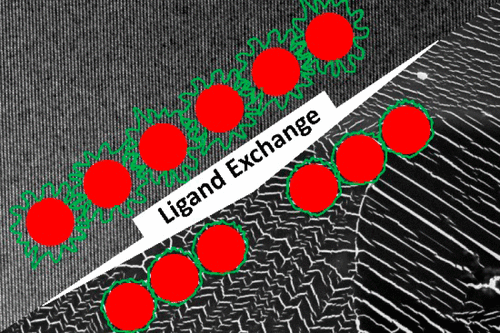当前位置:
X-MOL 学术
›
Nano Lett.
›
论文详情
Our official English website, www.x-mol.net, welcomes your feedback! (Note: you will need to create a separate account there.)
Anisotropic Cracking of Nanocrystal Superlattices
Nano Letters ( IF 10.8 ) Pub Date : 2017-09-25 00:00:00 , DOI: 10.1021/acs.nanolett.7b03123 Benjamin T. Diroll 1 , Xuedan Ma 2 , Yaoting Wu 1 , Christopher B. Murray 1, 3
Nano Letters ( IF 10.8 ) Pub Date : 2017-09-25 00:00:00 , DOI: 10.1021/acs.nanolett.7b03123 Benjamin T. Diroll 1 , Xuedan Ma 2 , Yaoting Wu 1 , Christopher B. Murray 1, 3
Affiliation

|
The synthesis colloidal nanocrystals in nonpolar organic solvents has led to exceptional size- and shape-control, enabling the formation of nanocrystal superlattices isostructural to atomic lattices built with nanocrystals rather than atoms. The long aliphatic ligands (e.g., oleic acid) used to achieve this control separate nanocrystals too far in the solid state for most charge-transporting devices. Solid-state ligand exchange, which brings particles closer together and enhances conductivity, necessitates large changes in the total volume of the solid (compressive stress), which leads to film cracking. In this work, truncate octahedral lead selenide nanocrystals are shown to self-assemble into body-centered cubic superlattices in which the atomic axes of the individual nanocrystals are coaligned with the crystal axes of the superlattice. Due to this coalignment, upon ligand exchange of the superlattices, cracking is preferentially observed on ⟨011⟩ superlattice directions. This observation is related to differences in the ligand binding to exposed {100} and {111} planes of the PbSe nanocrystal surfaces. This result has implications for binary and more complex structures in which differential reactivity of the constituent elements can lead to disruption of the desired structure. In addition, cracks in PbSe superlattices occur in a semiregular spacings inversely related to the superlattice domain size and strongly influenced by the presence of twin boundaries, which serve as both emission centers and propagation barriers for fractures. This work shows that defects, similar to behavior in nanotwinned metals, could be used to engineer enhanced mechanical strength and electrical conductivity in nanocrystal superlattices.
中文翻译:

纳米晶超晶格的各向异性开裂
在非极性有机溶剂中合成胶体纳米晶体导致异常的尺寸和形状控制,从而能够形成与由纳米晶体而非原子构成的原子晶格同构的纳米晶体超晶格。对于大多数电荷传输装置而言,用于实现该控制的长脂肪族配体(例如油酸)会分离出固态程度过高的纳米晶体。固态配体交换使粒子更接近并增强电导率,因此必须使固体总体积发生较大变化(压缩应力),这会导致膜破裂。在这项工作中,截短的八面体硒化铅纳米晶体显示为自组装成体心立方超晶格,其中各个纳米晶的原子轴与超晶格的晶轴共线。由于这种共排列,当超晶格进行配体交换时,优先在⟨011⟩超晶格方向上观察到龟裂。该观察结果与配体结合到PbSe纳米晶体表面的暴露的{100}和{111}平面上的差异有关。该结果对二元和更复杂的结构具有影响,其中组成元素的不同反应性可导致所需结构的破坏。此外,PbSe超晶格中的裂纹以与超晶格畴尺寸成反比的半规则间距出现,并受到双晶界的强烈影响,双晶界既是断裂的发射中心,又是断裂的传播屏障。这项工作表明,缺陷与纳米孪晶金属的行为相似,
更新日期:2017-09-26
中文翻译:

纳米晶超晶格的各向异性开裂
在非极性有机溶剂中合成胶体纳米晶体导致异常的尺寸和形状控制,从而能够形成与由纳米晶体而非原子构成的原子晶格同构的纳米晶体超晶格。对于大多数电荷传输装置而言,用于实现该控制的长脂肪族配体(例如油酸)会分离出固态程度过高的纳米晶体。固态配体交换使粒子更接近并增强电导率,因此必须使固体总体积发生较大变化(压缩应力),这会导致膜破裂。在这项工作中,截短的八面体硒化铅纳米晶体显示为自组装成体心立方超晶格,其中各个纳米晶的原子轴与超晶格的晶轴共线。由于这种共排列,当超晶格进行配体交换时,优先在⟨011⟩超晶格方向上观察到龟裂。该观察结果与配体结合到PbSe纳米晶体表面的暴露的{100}和{111}平面上的差异有关。该结果对二元和更复杂的结构具有影响,其中组成元素的不同反应性可导致所需结构的破坏。此外,PbSe超晶格中的裂纹以与超晶格畴尺寸成反比的半规则间距出现,并受到双晶界的强烈影响,双晶界既是断裂的发射中心,又是断裂的传播屏障。这项工作表明,缺陷与纳米孪晶金属的行为相似,



























 京公网安备 11010802027423号
京公网安备 11010802027423号